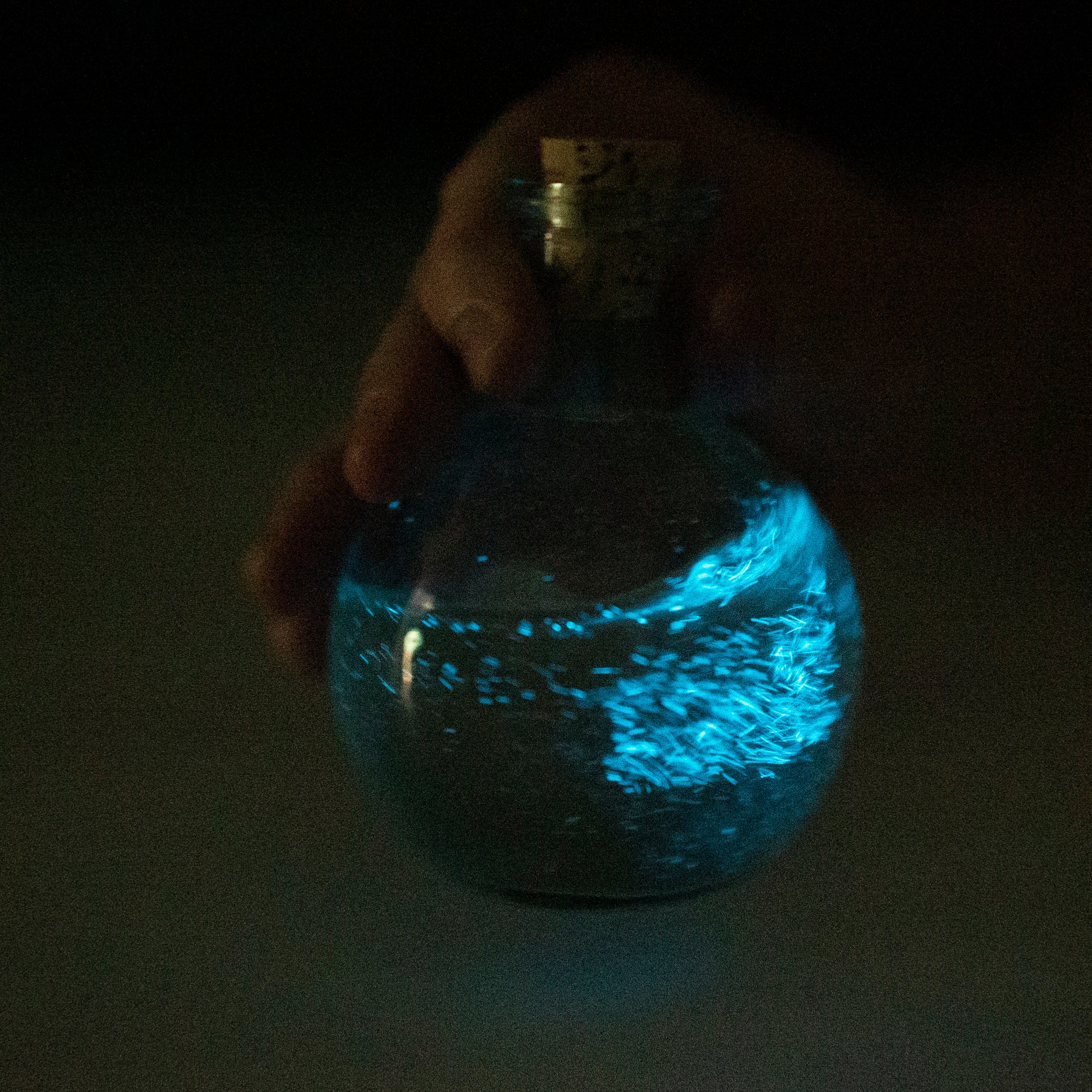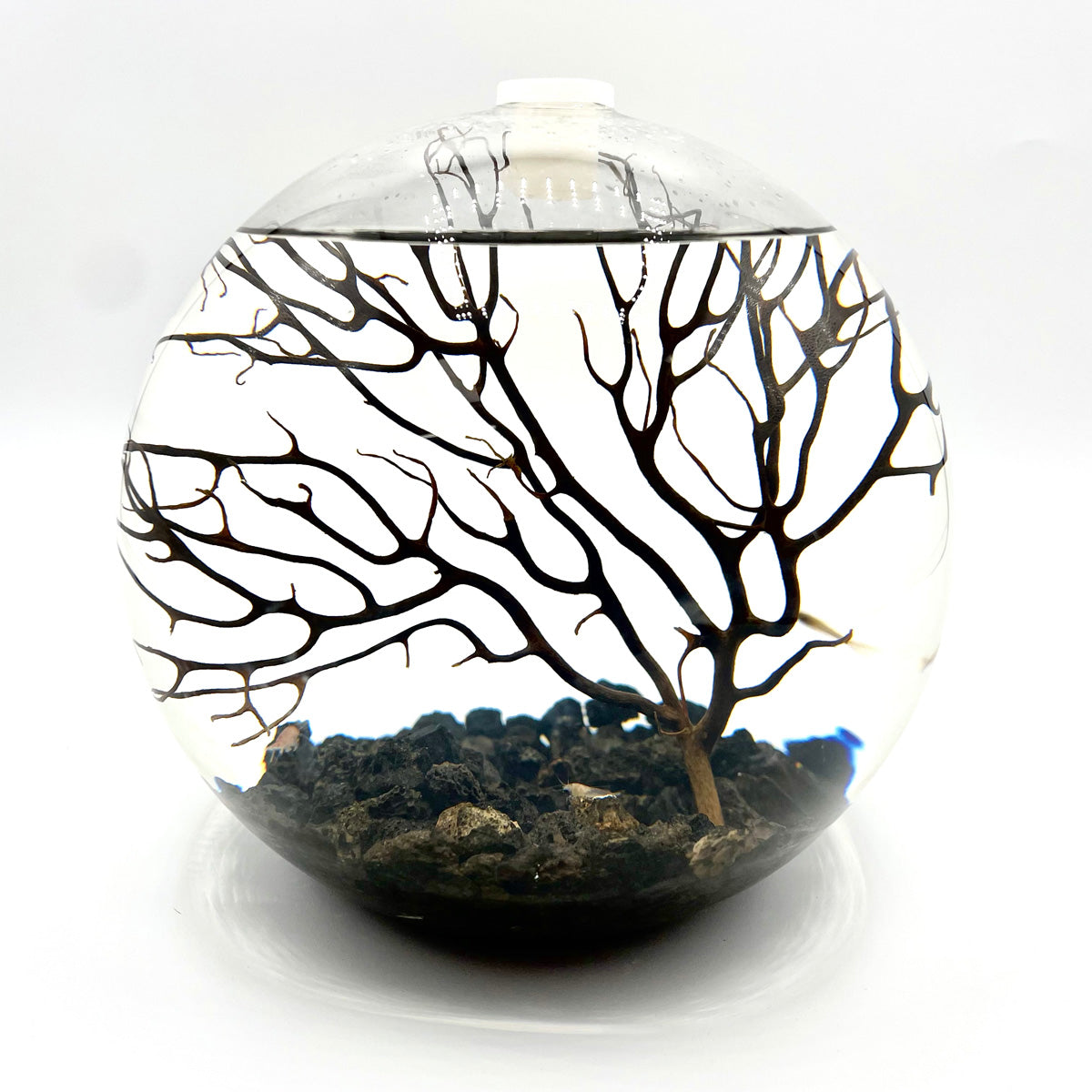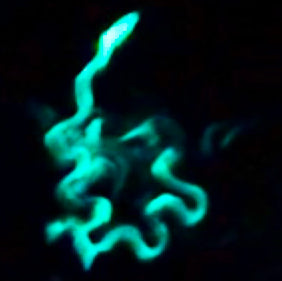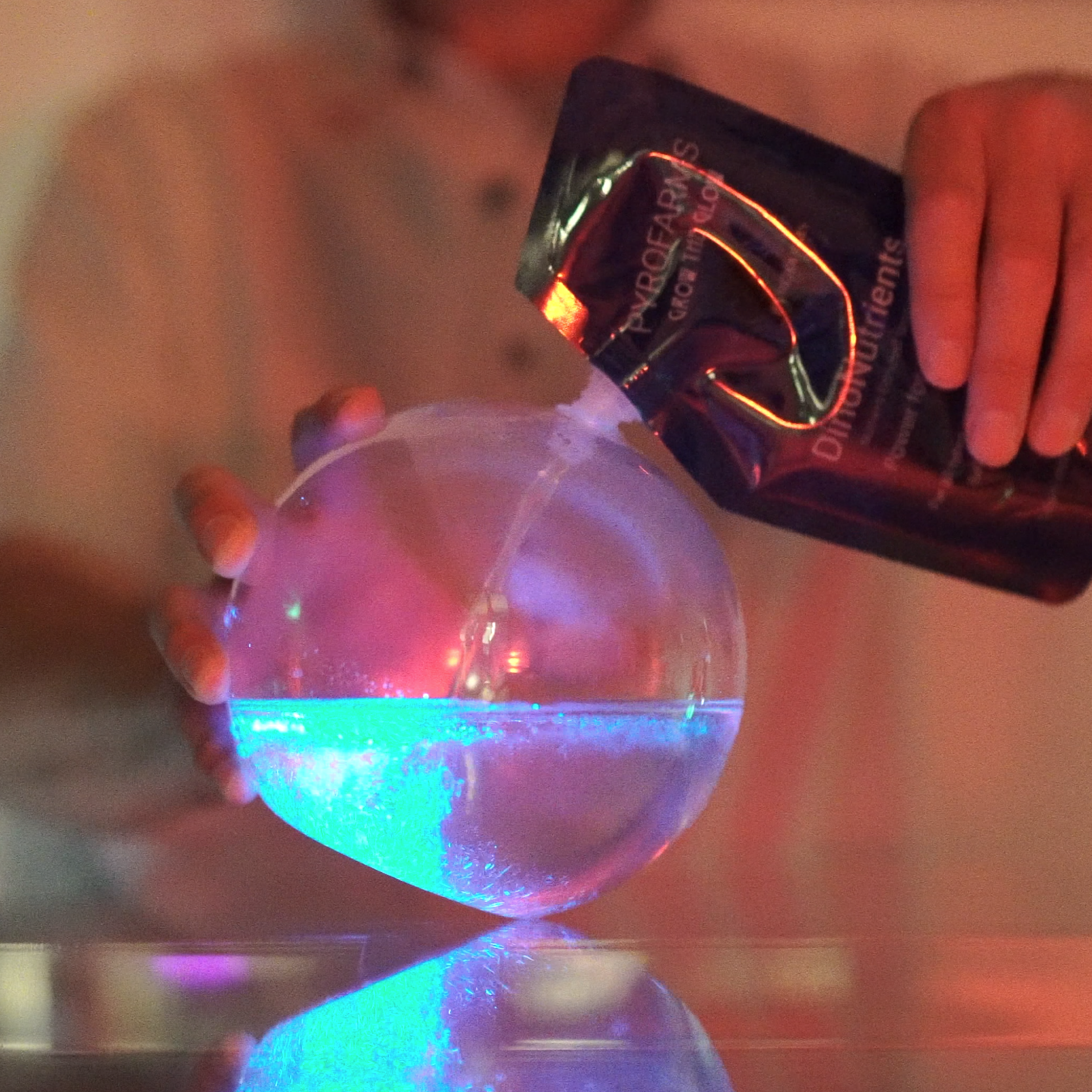Grow More - Glow More - Know More - An Overview

The Bio-Orb provides a new system for learning. The Bio-Orb is a glass micro-aquarium filled with bioluminescent phytoplankton (algae). Easy to care for, like a house plant, the Bio-Orb will produce natural light at night with no batteries or electricity. The Bio-Orb is a self-contained science lesson that provides the ideal environment for growing PyroDinos at home, in the classroom, or at the office. The Bio-Orb presents a wide range of science topics such as; bioluminescence, circadian rhythm, photosynthesis, carbon cycles, climate change, and marine food webs.
Grow More
Once you have PyroDinos, you can make more of them by giving them daily light and room to grow. 'Daily light' can be filtered/indirect sunlight or room lighting. 'Room to grow' means adding DinoNutrients which provides some added nutrients but, more importantly, space to grow.
Daily Light - PyroDinos are similar to a houseplant and require daily light. PyroDinos grow best when they receive about 12 hours of moderate light daily. Upon receiving your PyroDinos, immediately take the white pouch out of the shipping packaging and place it in a well-lit area. PyroDinos need sunlight to live and will not survive more than three days without light.
Moderate Temperatures - PyroDinos prefer mild temperatures, 9C to 31C (48F to 88F). Try to minimize temperature swings.
DinoNutrients - PyroDinos are grown in DinoNutrients (filtered purified seawater with added nutrients). PyroDinos can survive for several weeks, even months, with nothing but daily light. However, for optimal long-term health and to expand your culture (grow more PyroDinos), more DinoNutrients should be added. Giving your PyroDinos DinoNutrients is similar to giving a houseplant fertilizer.
Once you receive your PyroDinos, it is best not to add DinoNutrients for seven days. Let them recover from the stress of shipping. After the first 'feeding,' wait a few days or until your PyroDinos aggregate towards the top of the water line creating a thin brown line. Once this aggregation has formed, your PyroDinos are ready for more DinoNutrients.

The citizen scientists at PyroFarms have been growing PyroDinos for several years. A single PyroDino dinoflagellate cell was isolated off the coast of San Diego several years ago. PyroFarms has produced all their stock, trillions of cells from this single cell! Using natural and artificial lighting (LEDs) and adding DinoNutrients weekly, PyroFarms creates more and more PyroDinos (expansion).

The PyroDinos expand or 'grow' by multiplying. These cells multiply by cell division or 'asexual reproduction.' In asexual reproduction, one cell divides into two new daughter cells every 7 to 10 days (under ideal conditions). Scientists refer to these kinds of cells as 'immortal cells.'
Glow More - Bioluminescence
PyroDinos are best known for bioluminescence. Bioluminescence is the production of light by a living organism that occurs only at night, in the dark, and when these Dinos are gently agitated. Many other organisms produce bioluminescence. Some examples are fireflies, certain species of mushrooms and bacteria. However, when you see bioluminescence in a complex organism (like an Angler fish), it is most likely from a symbiotic bacteria living within that organism.
Bioluminescence occurs via a chemical reaction between a light-emitting molecule and an enzyme. These two compounds are luciferin and luciferase. During the night cycle these light-producing compounds are produced. Thus the longer into the night cycle the more potential for light production. Therefore, the best way to view dinoflagellate bioluminescence is in a dark room after the night cycle has begun.

The bioluminescence produced by these dinoflagellates is believed to act as a burglar alarm. The flashes of blue light attract a larger predator who will eat the PyroDinos' predators. (The enemy of my enemy is my friend). PyroDinos produce blue light because blue light wavelengths are more compact and travel more efficiently through seawater.
PyroDinos will only produce bioluminescence during nighttime hours (dark cycle), in the dark while swirled. The natural bioluminescence is transient and will only occur while the PyroDinos are in motion.
Know More
Photosynthesis is the process by which plants, algae (dinoflagellates) and some types of bacteria use sunlight, water and carbon dioxide to synthesize food and oxygen. Our PyroDinos perform photosynthesis daily and use light as their primary energy source. PyroDinos use sunlight to synthesize food from carbon dioxide (CO2) and water. Dinos generate oxygen (O2) as a byproduct. Thus these little Dinos, as a part of the larger plankton community, provide oxygen for us to breathe and help combat global warming by 'fixing' or removing carbon dioxide (CO2) from the atmosphere.
You probably heard it from someone, 71% percent of the Earth's surface is covered by water and over 95% of Earth's water is in its oceans. But did you know that over 70% of the oxygen we breathe comes from the oceans? Yes, primarily from these tiny plant-plankton called phytoplankton. Phytoplankton produce more than half the oxygen you are breathing right now? A thank you would be nice.

Circadian rhythm is defined as the physical and behavioral change that follows a daily cycle. This cycle is programmed by cycles of daylight and the absence of light. Did you know that you have a Circadian rhythm too? Dinos have this internal biological clock (Circadian rhythm) to help guide them towards the best time for photosynthesis and bioluminescence.
While photosynthesis constitutes a dinoflagellates' daytime routine, their nighttime routine (bioluminescence) gets all the attention. These Dinos can either photosynthesize or produce natural light. However, they can only do one of these actions at a time. Interestingly enough, their Circadian cycle can be modified or flipped over time (several days) by providing light at night and keeping them in the dark during the day. Over time (several days to a week), they will adapt to their new light cycle.

Dinoflagellates are a part of the plankton community and thus are the basis of the Ocean Food Web. All primary and secondary consumers, like marine fish and mammals (including whales & dolphins), rely on plankton directly or indirectly as a source of food and energy. Dinos play a role in this food web by converting light energy into chemical energy (photosynthesis). Unfortunately, this puts them squarely at the bottom of the food chain as autotrophic primary producers. So save some Dinos by keeping them as pets.
Algae could be our best ally in response to climate change. The oceans' algae do more than all land plants to reduce atmospheric carbon. When used in bioreactors, algae is 400 times more efficient than a tree at removing CO2 from the atmosphere. In addition, algae can consume more carbon dioxide than trees because it can cover more surface area and grow faster while producing more biomass in a limited space.
Algae can be utilized in several ways to reduce carbon in the atmosphere. Besides being the most efficient solution for storing carbon dioxide, it can be easily used in various other sustainable and commercial products or materials, from tennis shoes to steel alternatives to veggie burgers.
Algae is an increasingly viable alternative for many costly climate-change solutions. Next-generation companies are recognizing this opportunity and investing now, but it's also something that everyday people can consider as they look to reduce their environmental impact.
One study estimated that one acre of algae would remove 2.7 tons of CO2 daily. This effect would equal just 6% of Americans having a Large Bio-Orb in their home or office (just saying).




Comments
Dr. Mohd Khairul Afzan —
Hi, I would like to purchase this as my research study. However, I need to know how to grow the algae. is it possible to grow it for a large scale and a long time?
Arsalan —
Can i put these in my reef aquarium?